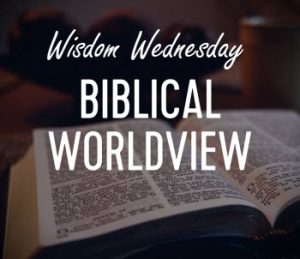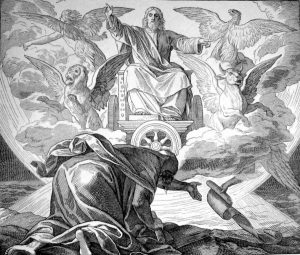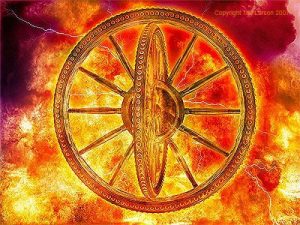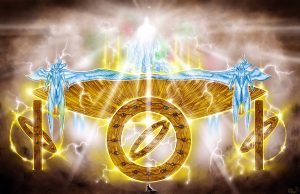
Shownotes
Wisdom-Trek / Creating a Legacy
Welcome to Day 961 of our Wisdom-Trek, and thank you for joining me.
I am Guthrie Chamberlain, Your Guide to Wisdom
Bizarre Visions for the Worst of Times – Wisdom Wednesday

Thank you for joining us for our five days per week wisdom and legacy building podcast. We are broadcasting from our studio at The Big House in Marietta, Ohio. Today is Day 961 of our trek, and it is Wisdom Wednesday.
Creating a Biblical Worldview is important to have a proper perspective on today’s current events. To establish a Biblical Worldview,you must also have a proper understanding of God’s Word. Especially in our western cultures, we do not fully understand the Scriptures from the mindset and culture of the authors. In order to help us all have a better understanding of some of the more obscure passages in God’s Word, we are investing Wisdom Wednesday reviewing a series of essays from one of today’s most prominent Hebrew Scholars Dr. Micheal S. Heiser. He has compiled these essays into a book titled I Dare You Not to Bore Me With the Bible.
If we are not studying God’s Word regularly and living by His precepts, we may have a very tainted perspective of God from some of the Old Testament passages. Today’s essay will explore:
Bizarre Visions for the Worst of Times

We are prone to make assumptions about God and His favor towards us when life has us down due to sin, mistakes, or incomprehensible circumstances. Of all the Scripture passages we might turn to during these times, the bizarre vision that opens the book of Ezekiel would not register high on our list. However, reading this passage with its original ancient context in mind reveals a powerful message
for its original recipients and for every believer.
· The Babylonian Context
If you have never read the visions contained within the book of Ezekiel, it is an unusual and fascinating read. Ezekiel had his vision in Babylon as one of the captive exiles (Ezekiel 1:1-3). Comparing his vision to Babylonian iconography reveals that Ezekiel saw a divine ‘”throne-chariot” of the heavens, widely described in the ancient biblical world. Just as human kings had chariots, so did deities. It is said that a deity would traverse the heavens in his chariot throne, inspecting his domain and exercising authority over it. In Ezekiel‘s vision, this throne sits above the surface or expanse in Ezekiel [1:26] which is the same word used in Genesis 1:6-8 for the heavens. Psalms [29:10] and Psalms 150:1 also gives us a snapshot of God’s abode.
Back to the divine throne, wheels supported the chariot throne, along with four unusual creatures identified as cherubim in Ezekiel 10:4. Each creature had four faces: human, lion, eagle, and ox (Ezekiel [1:10]). Next to each cherub were four gleaming wheels in Ezekiel [1:15]-16. These wheels were set on edge, since they are described as “tall” in Ezekiel [1:18]. They had wheels within them—that is, each one had at least one concentric circle within it. The vision describes the outer edge, or “rim,” of each wheel as having “eyes,” which is translated from the Hebrew word “Ayin.” The prophet Daniel, who was also in Babylon, described the very same blazing throne with wheels Dan 7:9.

· The Vision in Context
The four faces of the four animals or cherubim correspond to the iconography of the Babylonian zodiac. Each represents a seasonal constellation in Babylonian astrology, and each face or constellation also represented one of the four directions, North, South, East, and West. This is also referred to as the quadrants of the sky. Babylonians knew that the heavens were connected to what happened on earth such as times, seasons, crops, and weather. The Babylonians believed their gods controlled those functions. Information about the stars was laid out on Mesopotamian astrolabes, which were clay tablets whose concentric circles could well correspond to the “wheels within wheels” imagery.
English translations of Ezekiel’s vision often break down at the point where the prophet describes “eyes” on the rims of the wheels. The Hebrew word “Ayin” occurs a number of places throughout Ezekiel’s vision, but it is not always translated the same. At times it is translated as eyes. Taking the NLT as an example, “ayin” occurs six times in chapter 1 in verses 4, 7, 16, 18, 22, 27, but only translated as “eyes” in verse 18. In the vision’s description of the wheels and several other verses, the word “ayin” is translated as “sparkled” such as Ezekiel 10:9. Since ancient astronomical texts commonly describe shining stars as “eyes,” the Hebrew word “ayin” can refer to stars or their sparkling appearance. Many translators miss this possibility, failing to consider the astronomical context portrayed by the four faces.

· The Meaning of the Vision
During their time of exile, the Jewish captives might have easily believed Yahweh had abandoned them forever. Likewise, the Babylonians could have simply assumed their gods had defeated Yahweh and ruled the heavens and the earth unchallenged. But Ezekiel s imagery sends a message to the Jews in exile, and to their Babylonian captors: Both assumptions are flawed. Yahweh has not been defeated, nor has He turned away from His people, Israel. He remains seated in His chariot throne at the center of His domain, which is the entire cosmos. When we read Ezekiel 1 through ancient eyes, we can feel the same hope today. Even in the midst of difficult circumstances, we can know that an all-powerful God is active and present in our lives.
There is so much imagery in Ezekiel it is overwhelming trying just to picture it, let alone grasp its meaning. I encourage you to invest time considering the great God who reigns from His throne-chariot. Ezekiel 1:26-29 is just a glimpse of His splendor, “Above this surface was something that looked like a throne made of blue lapis lazuli. And on this throne high above was a figure whose appearance resembled a man. From what appeared to be his waist up, he looked like gleaming amber, flickering like a fire. And from his waist down, he looked like a burning flame, shining with splendor. All around him was a glowing halo, like a rainbow shining in the clouds on a rainy day. This is what the glory of the Lord looked like to me. When I saw it, I fell face down on the ground, and I heard someone’s voice speaking to me.”
That will conclude our essay for this week. Next Wisdom Wednesday we will continue with the Old Testament as we look at Dr. Heiser’s next essay titled “Answers from the Dead Sea Scrolls.” I believe you will find this another interesting topic to consider as we build our Biblical worldview.
Tomorrow we will continue with our 3-minute humor nugget that will provide you with a bit of cheer which will help you to lighten up and live a rich and satisfying life. So encourage your friends and family to join us and then come along with us tomorrow for another day of Wisdom-Trek, Creating a Legacy.

If you would like to listen to any of our past 960 treks or read the Wisdom Journal, they are available at Wisdom-Trek.com. I encourage you to subscribe to Apple Podcast or Google Podcast so that each day’s trek will be downloaded automatically.
Thank you for allowing me to be your guide, mentor, and most of all, your friend as I serve you through the Wisdom-Trek podcast and journal.
As we take this trek together, let us always:
- Live Abundantly (Fully)
- Love Unconditionally
- Listen Intentionally
- Learn Continuously
- Lend to others Generously
- Lead with Integrity
- Leave a Living Legacy Each Day
I am Guthrie Chamberlain reminding you to Keep Moving Forward, Enjoy Your Journey, and Create a Great Day Everyday! See you tomorrow!